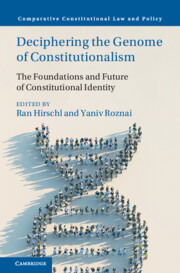Book contents
- Deciphering the Genome of Constitutionalism
- Comparative Constitutional Law and Policy
- Deciphering the Genome of Constitutionalism
- Copyright page
- Contents
- Figures
- Contributors
- Preface
- Acknowledgments
- Introduction
- Part I Foundations, Theory, and Concepts
- Part II Comparative Perspectives
- Part III American Constitutionalism and Constitutional Identity
- Part IV Emerging Trends
- 19 Constitution Making and Disharmonic Identity
- 20 Constitutional Identity and Unamendability
- 21 Illiberal Constitutionalism and the Abuse of Constitutional Identity
- 22 Deconstructing Constitutional Identity in Light of the Turn to Populism
- 23 Unconstitutional Constitutional Identities in The European Union
- 24 What Counts as Constitutional Identity?
- 25 Contrariness and Contradiction in Constitutional Law
- 26 Conclusion
- Index
- References
22 - Deconstructing Constitutional Identity in Light of the Turn to Populism
from Part IV - Emerging Trends
Published online by Cambridge University Press: 14 March 2024
- Deciphering the Genome of Constitutionalism
- Comparative Constitutional Law and Policy
- Deciphering the Genome of Constitutionalism
- Copyright page
- Contents
- Figures
- Contributors
- Preface
- Acknowledgments
- Introduction
- Part I Foundations, Theory, and Concepts
- Part II Comparative Perspectives
- Part III American Constitutionalism and Constitutional Identity
- Part IV Emerging Trends
- 19 Constitution Making and Disharmonic Identity
- 20 Constitutional Identity and Unamendability
- 21 Illiberal Constitutionalism and the Abuse of Constitutional Identity
- 22 Deconstructing Constitutional Identity in Light of the Turn to Populism
- 23 Unconstitutional Constitutional Identities in The European Union
- 24 What Counts as Constitutional Identity?
- 25 Contrariness and Contradiction in Constitutional Law
- 26 Conclusion
- Index
- References
Summary
Constitutional identity, although remaining distinct from national identity, does like the latter carve out an imagined community. It must process and reprocess material to promote a vision that integrates the ethnos and the demos in a constitutionally viable manner. In this pursuit, the elaboration of constitutional identity relies on three principal interpretive devices: negation, metaphor, and metonymy. The objective is to integrate the polity as a whole, the individuals subject to the constitution, and the plurality of groups within the nation that possess a legitimate claim to constitutional recognition. The resulting construct must draw on national identity to reinforce unity and depart from the latter where necessary to maintain constitutional integrity – e.g., to deescalate ethnic strife within the polity by banning ethnic-based political parties. The turn to populism poses a challenge that calls upon reframing constitutional identity. Indeed, as populism by its very nature casts only part of the people as the people, and labels those not included as the enemy, it calls for disaggregating and recombining existing liberal constitutional identities. We illustrate the adverse effect of populism’s recourse to ethnic cleavages and to religion in reframing constitutional identity through the salient example of Viktor Orban’s Hungary.
- Type
- Chapter
- Information
- Deciphering the Genome of ConstitutionalismThe Foundations and Future of Constitutional Identity, pp. 286 - 299Publisher: Cambridge University PressPrint publication year: 2024



